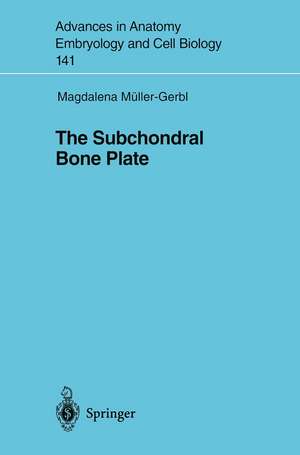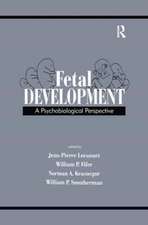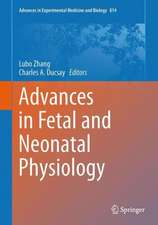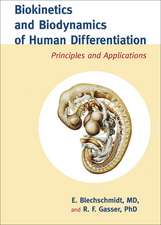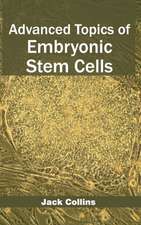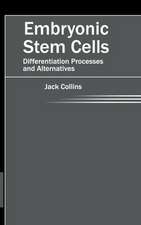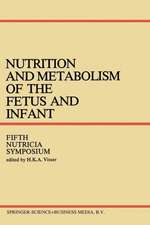The Subchondral Bone Plate: Advances in Anatomy, Embryology and Cell Biology, cartea 141
Autor Magdalena Müller-Gerblen Limba Engleză Paperback – 19 feb 1998
Din seria Advances in Anatomy, Embryology and Cell Biology
- 5%
 Preț: 1146.33 lei
Preț: 1146.33 lei - 5%
 Preț: 721.19 lei
Preț: 721.19 lei - 15%
 Preț: 637.13 lei
Preț: 637.13 lei -
 Preț: 381.81 lei
Preț: 381.81 lei - 15%
 Preț: 644.95 lei
Preț: 644.95 lei - 5%
 Preț: 1025.16 lei
Preț: 1025.16 lei - 15%
 Preț: 689.97 lei
Preț: 689.97 lei - 15%
 Preț: 577.07 lei
Preț: 577.07 lei - 15%
 Preț: 580.36 lei
Preț: 580.36 lei - 5%
 Preț: 393.51 lei
Preț: 393.51 lei -
 Preț: 408.66 lei
Preț: 408.66 lei -
![Die Schlüpfdrüse der Geburtshelferkröte (Alytes o. obstetricans [LAURENTI]) und anderer Froschlurche](https://i4.books-express.ro/bs/9783662239742/die-schluepfdruese-der-geburtshelferkroete-alytes-o-obstetricans-laurenti-und-anderer-froschlurche.jpg) Preț: 408.27 lei
Preț: 408.27 lei - 5%
 Preț: 1090.61 lei
Preț: 1090.61 lei - 5%
 Preț: 705.11 lei
Preț: 705.11 lei - 5%
 Preț: 706.04 lei
Preț: 706.04 lei - 5%
 Preț: 357.61 lei
Preț: 357.61 lei - 5%
 Preț: 704.59 lei
Preț: 704.59 lei - 5%
 Preț: 705.11 lei
Preț: 705.11 lei - 5%
 Preț: 359.42 lei
Preț: 359.42 lei - 5%
 Preț: 711.52 lei
Preț: 711.52 lei - 15%
 Preț: 635.47 lei
Preț: 635.47 lei - 15%
 Preț: 631.72 lei
Preț: 631.72 lei - 15%
 Preț: 633.35 lei
Preț: 633.35 lei - 15%
 Preț: 632.37 lei
Preț: 632.37 lei - 5%
 Preț: 706.60 lei
Preț: 706.60 lei - 15%
 Preț: 631.07 lei
Preț: 631.07 lei - 5%
 Preț: 707.13 lei
Preț: 707.13 lei - 5%
 Preț: 707.33 lei
Preț: 707.33 lei - 5%
 Preț: 359.60 lei
Preț: 359.60 lei - 5%
 Preț: 707.69 lei
Preț: 707.69 lei - 5%
 Preț: 707.13 lei
Preț: 707.13 lei - 5%
 Preț: 708.06 lei
Preț: 708.06 lei - 5%
 Preț: 706.41 lei
Preț: 706.41 lei - 5%
 Preț: 708.78 lei
Preț: 708.78 lei - 5%
 Preț: 705.68 lei
Preț: 705.68 lei - 5%
 Preț: 705.11 lei
Preț: 705.11 lei - 5%
 Preț: 706.77 lei
Preț: 706.77 lei - 15%
 Preț: 635.15 lei
Preț: 635.15 lei - 15%
 Preț: 631.07 lei
Preț: 631.07 lei - 5%
 Preț: 706.77 lei
Preț: 706.77 lei - 5%
 Preț: 706.04 lei
Preț: 706.04 lei - 5%
 Preț: 710.79 lei
Preț: 710.79 lei - 5%
 Preț: 705.32 lei
Preț: 705.32 lei - 15%
 Preț: 633.19 lei
Preț: 633.19 lei - 15%
 Preț: 629.09 lei
Preț: 629.09 lei - 15%
 Preț: 633.53 lei
Preț: 633.53 lei - 15%
 Preț: 632.70 lei
Preț: 632.70 lei - 15%
 Preț: 633.68 lei
Preț: 633.68 lei - 18%
 Preț: 773.72 lei
Preț: 773.72 lei - 15%
 Preț: 630.43 lei
Preț: 630.43 lei
Preț: 360.86 lei
Preț vechi: 379.86 lei
-5% Nou
Puncte Express: 541
Preț estimativ în valută:
69.05€ • 72.10$ • 57.02£
69.05€ • 72.10$ • 57.02£
Carte tipărită la comandă
Livrare economică 15-29 aprilie
Preluare comenzi: 021 569.72.76
Specificații
ISBN-13: 9783540636731
ISBN-10: 3540636730
Pagini: 152
Ilustrații: XI, 134 p. 77 illus., 1 illus. in color.
Dimensiuni: 155 x 235 x 8 mm
Greutate: 0.22 kg
Editura: Springer Berlin, Heidelberg
Colecția Springer
Seria Advances in Anatomy, Embryology and Cell Biology
Locul publicării:Berlin, Heidelberg, Germany
ISBN-10: 3540636730
Pagini: 152
Ilustrații: XI, 134 p. 77 illus., 1 illus. in color.
Dimensiuni: 155 x 235 x 8 mm
Greutate: 0.22 kg
Editura: Springer Berlin, Heidelberg
Colecția Springer
Seria Advances in Anatomy, Embryology and Cell Biology
Locul publicării:Berlin, Heidelberg, Germany
Public țintă
ResearchCuprins
1 Introduction (Review of Literature).- 1.1 Preliminary Remarks.- 1.2 General Mechanisms for the Regulation of the Morphology of Bone Tissue.- 1.3 Morphology of the Subchondral Bone.- 1.4 Function of the Subchondral Bone Plate.- 1.5 Possible Pathomechanisms Leading to Osteoarthritic Changes.- 1.6 Factors Regulating the Remodeling of the Subchondral Bone.- 1.7 The Aims of this Investigation.- 2 Materials.- 2.1 Material for the Validation of CT-OAM.- 2.2 Materials Used for CT-OAM.- 3 Methods.- 3.1 X-ray Densitometry.- 3.2 CT OAM Used to Demonstrate the Patterns of Subchondral Mineralization in the Living Subject.- 3.3 The Production of Secondary Sections.- 3.4 Dual-energy QCT with basis material decomposition.- 3.5 Methods of Achieving Standardized Evaluation and Quantification of the Mineralization Patterns.- 4 Validation of CT OAM.- 4.1 Comparison with Conventional Procedures.- 4.2 Dependence of the Absorption Value on the Calcium Concentration.- 4.3 The Use of CT OAM in Connection With Sections Cut at Other Angles.- 5 Mineralization Patterns in Healthy Subjects.- 5.1 Vertebral Column (Lumbar Region).- 5.2 Shoulder Joint.- 5.3 Elbow Joint.- 5.4 Radiocarpal Joint.- 5.5 Hip Joint.- 5.6 Femorotibial Joint.- 5.7 Femoropatellar Joint.- 5.8 Ankle Joint.- 6 Pathological Mineralization Patterns.- 6.1 Vertebral Column.- 6.2 Shoulder Joint.- 6.3 Radiocarpal Joint.- 6.4 Hip Joint.- 6.5 Femorotibial Joint.- 6.6 Femoropatellar Joint.- 7 Factors Influencing the Development of Normal Patterns of Mineralization.- 7.1 The Shape of the Joint Surfaces.- 8 Factors Influencing the Development of Pathological Patterns of Mineralization.- 8.1 Abnormal Geometrical Relationships.- 8.2 Changes in the Magnitude of the Joint Reaction Force.- 8.3 Changes in Size and Position of the Contact Surfaces.- 8.4 Changes in the Penetration Point of the Joint Reaction Force.- 8.5 The Temporal Course of the Changes.- 9 Possible Clinical Application of CT OAM.- 9.1 Basic Clinical Research.- 9.2 Diagnosis.- 9.3 Following the Progress of Treatment.- 10 Summary.- References.
Textul de pe ultima copertă
This monograph offers a comprehensive review of present knowledge of the structure.... (Text forwarded to production editor, diskette available, please contact A. Clauss)
